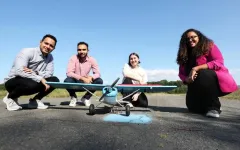(Press-News.org) U.S. immigration law and the legal categorizations it imposes on migrants shape the journeys of migrant children from Central America as they move through Mexico toward the southern U.S. border, according to a new Yale study.
In the study, sociologist Ángel Escamilla García documents the various hard decisions Central American youth are forced to make during their journeys to maximize their chances of not being deported once they reach the United States. Those choices include concealing sexual assaults, beatings, and other crimes inflicted on them during their travels; drastically altering their routes through Mexico; and separating from their family members before attempting to cross the border.
The study, published in the journal Ethnic and Racial Studies, is based on interviews and focus groups that Escamilla García conducted with 32 minors who were migrating to the United States from Guatemala, Honduras, and El Salvador. He spoke with the participants at migrant shelters in four locations in southern and northern Mexico.
His findings shed light on the ways migrant youth learn about the legal classifications of people under U.S. immigration law and assess how those categories account for their experiences while traveling.
“The legal categories created by U.S. immigration law have an impact that extends well beyond the county’s territorial borders, which makes journeys of vulnerable groups, such as unaccompanied children, slower and more perilous,” said Escamilla García, assistant professor of sociology in Yale’s Faculty of Arts and Sciences. “Something I found fascinating about the youth I met in Mexico was the amount of knowledge circulating among them about U.S. immigration law. They would assess how they thought the laws would affect their cases, which led them to make decisions that were risky but aimed at enhancing their chances of gaining legal status in the United States.”
Undocumented minors who enter the United States without a parent or legal guardian are categorized as unaccompanied children (UACs), a group considered vulnerable and treated differently from other undocumented migrants.
UACs entering the United States most commonly apply for one or both of two types of immigration relief — asylum and Special Immigrant Juvenile Status — that extend legal status to migrants fearful of returning to their countries of origin, Escamilla García explained. Qualifying for either designation requires meeting parameters that govern eligibility.
Escamilla García found that minors traveling through Mexico learn about U.S. immigration law primarily through three sources: conversations with other migrants (the source of information for 50% of migrants); consultations with lawyers and staff at migrant shelters (20%); and through social media apps (30%), including Facebook and WhatsApp groups.
Acquiring knowledge can cause minor migrants to conceal sexual assaults, brutal physical violence, and other crimes experienced during their journeys, Escamilla García said.
Edelmira, a 17-year-old girl Escamilla García interviewed for the study, said she was sexually assaulted soon after she crossed the border from her home county of Honduras into Mexico. She suffered headaches and stomach pain afterward but decided not to report the crime after learning that rape and other physical violence migrants suffer en route to the United States is irrelevant to their asylum applications, Escamilla García said.
“The attorneys already told me that it’s good to report violence so that the authorities know what is happening, but they also told me that what happened to me here doesn’t matter in my case up there [in the U.S.],” Edelmira told Escamilla García.
UACs, as a protected class, are allowed to remain in the United States while their immigration cases are pending. They can be reunified with a family member or other qualified individual to care for them as their cases progress. Lacking a sponsor, they are put in the care of the federal Office of Refugee Resettlement, which places them in a shelter or, for young children, with a foster family.
Facundo, a 17-year-old Guatemalan, told Escamilla García he had pre-arranged to have a family friend who lived in Florida meet him at the border but had to change plans after learning that he could be locked up for months in a detention center if his sponsor was not a relative. He was instead attempting to make new arrangements with an uncle who lives in New York, but since that uncle is undocumented Facundo would have had to meet him at a different location on the border than where he had planned to meet the family friend. Changing sponsors added stress to Facundo’s journey — and caused him to change his route mid-journey, Escamilla García said.
Some of the migrant minors who were interviewed calculated that they had a better chance of remaining in the United States if they arrived at the border alone, and so separated from family members during their journey through Mexico.
For example, Junior, a 17-year-old from Guatemala, decided to separate from his two adult brothers at a city on the U.S.-Mexico border after realizing that he could cross more easily as a UAC, Escamilla García said.
“These decisions, all made by vulnerable young people as they are traveling across Mexico toward uncertainty on the U.S. border, demonstrate that migrant minors have agency,” he said. “They’re not naïve. They react to what they learn and change plans due to legal considerations based on their knowledge of U.S. immigration law.”
# # #
END
RICHLAND, Wash.—Scientists are gathering at the Department of Energy’s Pacific Northwest National Laboratory this week for a first-ever conference to consider ways to protect critical systems such as our electrical grid, water treatment plants and financial networks that are vulnerable in new ways.
The Cyber Supply Chain Risk Management Conference, known as CySCRM 2024, is being held on the PNNL campus Tuesday-Wednesday, Oct. 29-30.
It’s a new kind of science meeting, one that scientist Jess Smith and colleagues felt compelled to create as they eye a new kind of risk—a ...
Newly available blood tests to screen for colorectal cancer sound far more appealing than a standard colonoscopy. Instead of clearing your bowels and undergoing an invasive procedure, the tests require only a simple blood draw. But are the tests effective?
A study led by researchers at Stanford Medicine concluded that the new tests are ideal for people who shy away from other colorectal cancer screening. However, if too many people who would have undergone colonoscopies or stool-based tests switch to the blood tests, colorectal cancer death rates will rise. Because the more established colonoscopies and stool tests ...
Embargoed for release until 5:00 p.m. ET on Monday 28 October 2024
@Annalsofim
Below please find summaries of new articles that will be published in the next issue of Annals of Internal Medicine. The summaries are not intended to substitute for the full articles as a source of information. This information is under strict embargo and by taking it into possession, media representatives are committing to the terms of the embargo not only on their own behalf, but also on behalf of the organization they represent. ...
Derek Urwin has a special stake in his work as a cancer control researcher. After undergraduate studies in applied mathematics at UCLA, he became a firefighter. His inspiration to launch a second career as a scientist was the loss of his brother, Isaac, who died of leukemia at only 33 despite no history of cancer in their family. Working with Anastassia Alexandrova, a professor of chemistry and biochemistry in the UCLA College, he earned his doctorate.
Urwin is now a UCLA adjunct professor of chemistry — and still a full-time firefighter with the Los Angeles County Fire Department. In a recent publication, his science shed new light on the chemical underpinnings of exposures ...
PHILADELPHIA (October 28, 2024) – The University of Pennsylvania School of Nursing (Penn Nursing) has been awarded a $3.2 million, 5-year grant from the National Institute of Nursing Research (NINR) to scale out an evidence-based secure firearm storage intervention at Children’s Hospital of Philadelphia (CHOP). Firearms are now the leading cause of death for U.S. children and teens, driving the largest spike in children’s mortality in more than 50 years. The study aims to keep children safer from firearm injury and mortality by promoting secure firearm storage.
The intervention, ...
Taking inspiration from bird feathers, Princeton engineers have found that adding rows of flaps to a remote-controlled aircraft’s wings improves flight performance and helps prevent stalling, a condition that can jeopardize a plane’s ability to stay aloft.
“These flaps can both help the plane avoid stall and make it easier to regain control when stall does occur,” said Aimy Wissa, assistant professor of mechanical and aerospace engineering and principal investigator of the study, published in the Proceedings ...
Marine phytoplankton are fundamental to Earth’s ecology and biogeochemistry. Our understanding of the large-scale dynamics of phytoplankton biomass has greatly benefited from, and is largely based on, satellite ocean color observations from which chlorophyll-a (Chla), a commonly used proxy for carbon biomass, can be estimated. However, ocean color satellites only measure a small portion of the surface ocean, meaning that subsurface phytoplankton biomass is not directly monitored. Chla is also an imperfect ...
Images
There's a famous piece of advice from hockey, attributed to Wayne Gretzky, about how it's better to skate to where the puck is headed rather than where it is.
Research is now showing that regulations designed to protect Lake Erie's water quality are heeding the Great One's words when it comes to safeguarding the Great Lake's fisheries.
Specifically, the currently recommended limits on the flow of nutrients into Lake Erie from agriculture may be too restrictive for some species of fish. They are, however, suited to maintain healthy fisheries until the ...
201.6 million years ago, one of the Earth's five great mass extinctions took place, when three-quarters of all living species suddenly disappeared. The wipeout coincided with massive volcanic eruptions that split apart Pangaea, a giant continent then comprising almost all the planet's land. Millions of cubic miles of lava erupted over some 600,000 years, separating what are now the Americas, Europe and North Africa. It marked the end of the Triassic period and the beginning of the Jurassic, the period when dinosaurs arose to take the place of Triassic creatures and dominate the planet.
The exact mechanisms of the End Triassic Extinction have long been debated, ...
“We found that 30 percent of the regions with available data have fully decoupled carbon emissions from economic growth. Regions with high incomes and a history of carbon-intensive industries, as well as those with significant shares of service and manufacturing sectors were particularly successful in reducing carbon emissions while still experiencing economic growth,“ says Anders Levermann, co-author and head of the research department “Complexity Science” at PIK. “A stabilization of the global mean temperature is only possible with net-zero carbon emissions. That ...




